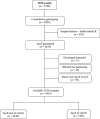Associations of one-carbon metabolism, related B-vitamins and ApoE genotype with cognitive function in older adults: identification of a novel gene-nutrient interaction
- PMID: 40717068
- PMCID: PMC12302869
- DOI: 10.1186/s12916-025-04276-8
Associations of one-carbon metabolism, related B-vitamins and ApoE genotype with cognitive function in older adults: identification of a novel gene-nutrient interaction
Abstract
Background: The role of one-carbon metabolism and related B-vitamins in cognitive function in ageing is well-documented, particularly for folate and vitamin B12, with vitamin B6 and riboflavin receiving much less attention. ApoE is a well-established genetic risk factor for Alzheimer's disease, but the role of B-vitamins in modifying this risk remains largely unexplored. We examined associations between folate, B12, B6, riboflavin, and cognitive function in older adults, including interactions with the ApoE ε4 genotype.
Methods: Community-dwelling older adults (≥ 60 years) from the Trinity-Ulster-Department of Agriculture (TUDA) study were stratified as ApoE ε4 carriers (ε3/ε4 and ε4/ε4 genotypes; n = 1205) or non-ε4 carriers (n = 3348). Cognitive function was assessed using the Repeatable Battery for Assessment of Neuropsychological Status (RBANS), the Frontal Assessment Battery, and the Mini-Mental State Examination. Logistic regression models were used to evaluate the association between cognitive dysfunction (defined as RBANS score < 80) and a range of variables, including biomarkers of folate, vitamins B12, B6, and riboflavin status, plasma homocysteine levels, and ApoE ε4 genotype.
Results: Lower status of vitamin B12 (holotranscobalamin; adjusted odds ratio (ORadj 1.30; 95% CI: 1.08-1.58, p = 0.007), vitamin B6 (ORadj 1.37; 95% CI: 1.12-1.67, p = 0.002), riboflavin (ORadj 1.73; 95% CI: 1.44-2.09, p < 0.001), and higher plasma homocysteine (ORadj 1.50; 95% CI: 1.22-1.83, p < 0.001) were each associated with higher risk of cognitive dysfunction. The ApoE ε4 genotype interacted adversely with low B12 status (p = 0.030) and elevated homocysteine (p = 0.008) in relation to cognitive outcomes.
Conclusions: Low status of vitamin B12, B6, riboflavin, and/or elevated homocysteine were each associated with a greater risk of cognitive dysfunction. A novel interaction between ApoE ε4 and low B12 or higher homocysteine was associated with an increased risk of cognitive dysfunction. Improving B-vitamin status may have important public health benefits for dementia prevention. Further investigation, ideally in the form of randomised trials, is however required to demonstrate a causative relationship and confirm whether intervention with B-vitamins can confer a beneficial effect in maintaining better cognitive health in at-risk older people.
Trial registration: TUDA study: ClinicalTrials.gov no. NCT02664584 (27/01/2016).
Keywords: Apolipoprotein E (ApoE ε4); Cognitive function; Folate; Homocysteine; One-carbon metabolism; Riboflavin; Trinity-Ulster-Department of Agriculture (TUDA); Vitamin B12; Vitamin B6.
© 2025. The Author(s).
Conflict of interest statement
Declarations. Ethics approval and consent to participate: Ethical approval was granted by the Office for Research Ethics Committees Northern Ireland (ORECNI; 26 March 2009; reference 08/NI/RO3113), with corresponding approvals from the Northern and Western Health and Social Care Trust and the Research Ethics Committee of St James Hospital and The Adelaide and Meath Hospital in Dublin (7 November 2008). All participants provided written informed consent at the time of recruitment. Consent for publication: Not applicable. Competing interests: The authors declare no competing interests.
Figures


Similar articles
-
Folic acid with or without vitamin B12 for cognition and dementia.Cochrane Database Syst Rev. 2003;(4):CD004514. doi: 10.1002/14651858.CD004514. Cochrane Database Syst Rev. 2003. Update in: Cochrane Database Syst Rev. 2008 Oct 08;(4):CD004514. doi: 10.1002/14651858.CD004514.pub2. PMID: 14584018 Updated.
-
The effect of vitamin B6 on cognition.Cochrane Database Syst Rev. 2003;(4):CD004393. doi: 10.1002/14651858.CD004393. Cochrane Database Syst Rev. 2003. PMID: 14584010
-
Folic acid with or without vitamin B12 for the prevention and treatment of healthy elderly and demented people.Cochrane Database Syst Rev. 2008 Oct 8;(4):CD004514. doi: 10.1002/14651858.CD004514.pub2. Cochrane Database Syst Rev. 2008. PMID: 18843658
-
Vitamin B12 and Folate Status in Cognitively Healthy Older Adults and Associations with Cognitive Performance.J Nutr Health Aging. 2021;25(3):287-294. doi: 10.1007/s12603-020-1489-y. J Nutr Health Aging. 2021. PMID: 33575718 Free PMC article.
-
A critical evaluation of the relationship between serum vitamin B, folate and total homocysteine with cognitive impairment in the elderly.J Hum Nutr Diet. 2004 Aug;17(4):371-83; quiz 385-7. doi: 10.1111/j.1365-277X.2004.00532.x. J Hum Nutr Diet. 2004. PMID: 15250847
References
-
- Livingston G, Huntley J, Liu KY, Costafreda SG, Selbæk G, Alladi S, et al. Dementia prevention, intervention, and care: 2024 report of the Lancet standing Commission. Lancet. 2024;404(10452):572–628. - PubMed
-
- Baumgart M, Snyder HM, Carrillo MC, Fazio S, Kim H, Johns H. Summary of the evidence on modifiable risk factors for cognitive decline and dementia: A population-based perspective. Alzheimers Dement. 2015;11(6):718–26. - PubMed
-
- Loy CT, Schofield PR, Turner AM, Kwok JB. Genetics of dementia. Lancet. 2014;383(9919):828–40. - PubMed
Publication types
MeSH terms
Substances
Associated data
LinkOut - more resources
Full Text Sources
Medical
Miscellaneous

